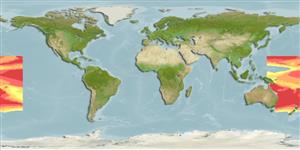Teleostei (teleosts) >
Aulopiformes (Grinners) >
Paralepididae (Barracudinas)
Etymology: Lestidium: Related to Greek, lestes = thief + Greek, ops = appearance (Ref. 45335).
More on author: Gilbert.
Environment: milieu / climate zone / depth range / distribution range
Ecology
Marine; bathypelagic; depth range 183 - 700 m (Ref. 58302). Deep-water; 23°N - 49°S, 140°E - 153°W
Pacific Ocean.
Size / Weight / Age
Maturity: Lm ? range ? - ? cm
Max length : 24.7 cm SL male/unsexed; (Ref. 121637)
Short description
Identification keys | Morphology | Morphometrics
Body moderately long, not especially slender; luminescent duct in abdominal cavity unbranched, extending forward to below opercle or before anterior margin of eye; nostrils well before a vertical through posterior end of maxilla; no light organ at anterior margin of orbit; anal-fin rays 26-34; incomplete lateral line, extending only to above the anterior third of anal-fin base; total lateral-line scales are 84-87, with 64-68 large scales, followed by 15-21 smalles scales; branchiostegal membranes and rays entirely black (Ref. 123138).
Cross section: compressed.
Meso- or perhaps benthopelagic (Ref. 58302).
Life cycle and mating behavior
Maturity | Reproduction | Spawning | Eggs | Fecundity | Larvae
Tinker, S.W., 1978. Fishes of Hawaii, a handbook of the marine fishes of Hawaii and the Central Pacific Ocean. Hawaiian Service Inc., Honolulu. 568 p. (Ref. 583)
IUCN Red List Status (Ref. 130435: Version 2025-1)
Threat to humans
Harmless
Human uses
Fisheries: bycatch
Tools
Special reports
Download XML
Internet sources
Estimates based on models
Preferred temperature (Ref.
123201): 9.1 - 18.6, mean 13.3 °C (based on 62 cells).
Phylogenetic diversity index (Ref.
82804): PD
50 = 0.5039 [Uniqueness, from 0.5 = low to 2.0 = high].
Bayesian length-weight: a=0.00224 (0.00091 - 0.00552), b=3.08 (2.86 - 3.30), in cm total length, based on LWR estimates for this (Sub)family-body shape (Ref.
93245).
Trophic level (Ref.
69278): 3.9 ±0.6 se; based on size and trophs of closest relatives
Resilience (Ref.
120179): High, minimum population doubling time less than 15 months (Preliminary K or Fecundity.).
Fishing Vulnerability (Ref.
59153): Low vulnerability (20 of 100).
🛈
